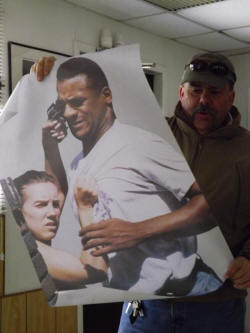 The facility, which was designed by Yanor, is located near Lincoln
in a heavily wooded area. Nichols said the location is not widely
publicized, though there are members of the public who know where it
is. The facility, which was designed by Yanor, is located near Lincoln
in a heavily wooded area. Nichols said the location is not widely
publicized, though there are members of the public who know where it
is.Going into the Range, the best way to describe the site is to
picture something from an extreme survivalist movie where there is a
compound with various outbuildings, shooting ranges and targets.
All of this is set in bottom ground with hills and trees
surrounding it. At the first stop there is a double-wide portable
classroom and target ranges. Several hundred feet into the woods is
a 4,000-square-foot building constructed of railroad ties. This
building is where those in training will practice making entry into
possibly volatile situations.
The shooting building is designed with doors on every wall.
Panels are moved from time to time during exercises to block one or
more doors, making the rooms and the floor plan different for each
exercise. Inside each room, outdoor furniture and other items are
used to simulate what an officer might encounter upon entering a
home, business or school.

On one side of the building is a long hallway about the width of
what one would encounter in a school. For the most part, the
building is without a roof, but in this hallway a portion of it is
roofed. Yanor explained they do this because changes in light can
play tricks on the eyes, and they want officers to understand what
is going to happen when they go from, for example, the bright
sunlight outside directly into a darkened area.
During trainings in the shoot house, various targets are used.
The targets are photographic images of people in different
situations. As trainees go through the rooms, there will be images
of innocent people who are hiding from a shooter or trying to escape
the building, and there will be images of the "bad guys." In the
exercise the officers have to quickly examine the image and
determine if they should shoot.
In a real-life situation, a second of hesitation can cost an
officer his life, and being too hasty can result in innocent victims
being injured. Officers must in a split-second examine the subject
and make a decision that is correct.
In the portable classroom, Yanor pulled out a couple of these
images to show an example of what an officer might find, not only in
the shoot house but also in real life.

The first image included two males, an adult and a child of about
10. The adult is holding the boy in front of him with his hand on
the boy's throat, and in the other hand he holds a pistol. In that
particular image, it is pretty easy to see who the bad guy is. The
second one Yanor showed was not as clear-cut.

In the second image there are two adults: one male, one female.
The male in the photo is large and muscular; the female short and
slim. To those who lack the proper training, the focus goes to the
male in the photo, as many stereotypically will assume the male is
the aggressor. However, when given time to study the picture, it is
the female who is holding a gun to the head of the male, not vice
versa.
Yanor said that in training inside the shoot house, they take a
"crawl, walk, run" approach. The first time a team goes through the
shoot house, they do a walk-through with an instructor. The second
time, the trainees go in solo, but at a slower pace, allowing them
time to evaluate what they see and act accordingly. Then finally,
the trainees go in at a quick pace, making split-second decisions as
they would in real life.
[to top of second column] |

The exercises are also filmed so that afterward instructors and
trainees can evaluate the exercise and see firsthand what went well
and what might have gone wrong.
Talking about the importance of this type of training, the
subject of school violence came into play. Nichols and Yanor
said that having live exercises will help officers if they
should be called into something like a school shooting. Yanor
said that during training, officers do exercises with a variety
of team members and also do one-man exercises.
He drove home that this was important because an officer may
arrive on the scene first with backup a few minutes away. "You know
what that officer is going to do," Yanor said. "He's going to go in,
and he may be the only one in the building to clear it." Because of
this, those first responders need to know how to work alone, but
they also need to know how to work as a group.
Nichols also emphasized that the live experience is better than
working with simulations in situation rooms. He said that when
standing around a table talking about what to do in a given
situation, it is easier to think it out and see the entire
situation.
Having taken the training himself, Nichols also said that during
live training, he felt the adrenaline and the tension of the
unknown. He said for him it was as close to the real thing as anyone
could get.
It may be hard to imagine, but the training center in Lincoln is
known all around the United States as a top-notch facility for
tactical training. Inside the classroom area, the walls are covered
with badges from the various police departments and other law
enforcement bodies that have taken training at The Range.

Included in the wall of badges are those from as far away as
California and also the Southern states. The Range has also been the
location for special training for many university security and
police departments, including the University of Illinois, Illinois
State, Eastern Illinois University and several others.
In the classroom area, the setup is pretty simple: tables and
chairs for class time and a coffeepot to help keep people energized.
The room also houses several special pieces of equipment that
officers eventually learn how to use on the range and in the shoot
house.
Some of the more interesting items are the large black shields
used for riot control and a special explosive device used to open
locked doors.

The riot shields look very much like what are seen on television.
They are large, heavy, black, bulletproof body shields with a thin
window for seeing out. What one doesn't see on television is that
the shields weigh about 50 pounds. Most often a police officer holds
the shield using a hook that goes over the arm below the elbow and
another that is gripped in the hand. While holding the shield with
the one arm, officers oftentimes are also holding a weapon in the
other.

The explosive device used for breaching locked doors is
specifically designed with a charge just strong enough to blow a
door. Yanor explained that the devices can be sized to fit the need,
including blowing holes in 6-inch concrete.
___
In Part 2, Yanor and Nichols will explain how this type of
training center came to be in Logan County and how all of this has
been accomplished without one dollar of taxpayer money.
[By NILA SMITH] |